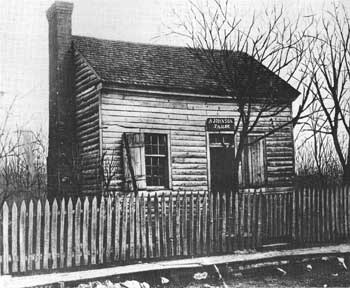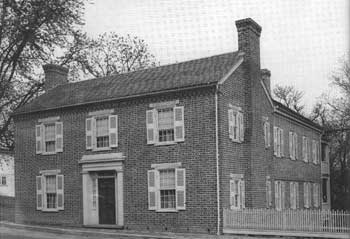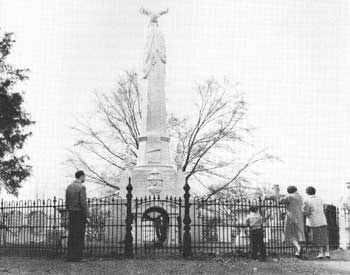






Survey of
Historic Sites and Buildings
 |
Johnson (Andrew) National Historic Site Tennessee |
 Andrew Johnson National Historic Site |
| ||
Andrew Johnson National Historic Site dramatically illustrates Johnson's rise from very humble beginnings to the Presidency. Three structures, at separate but nearby locations, represent nearly 45 years of his life: the tailor shop he owned for many years and two of his residences. The cemetery in which he is buried is also in the national historic site.
In the fall of 1826 Johnson, a 17-year-old and almost illiterate tailor's apprentice, arrived in Greeneville, Tenn., from North Carolina with his impoverished family, consisting of his mother, brother, and stepfather. Unable to find employment there, Andrew moved on to Rutledge, about 40 miles to the west, and possibly other towns and villages in eastern Tennessee, working as a tailor. The next spring, however, by which time conditions in Greeneville had improved, he returned.
Within a short time, Johnson married Eliza McCardle and settled down in a two-room frame-puncheon board house on Main Street, which he apparently rented. He used one room as a shop and resided in the other. In this crowded structure, his wife gave birth to two of their five children. She also taught him to write and helped improve his rudimentary knowledge of reading.
 |
| Early view of Andrew Johnson's tailor shop, which is now preserved inside a brick shelter. (Library of Congress.) |
In 1831, his tailor business prospering, Johnson acquired a more substantial two-story brick dwelling at the northeast corner of Water and Main Cross (present College and Depot) Streets. About the same time, he purchased a lot across Water Street opposite the house. He may have moved there from another location, for use in his tailor business, a one-room frame structure or may have utilized one already standing on the site.
In 1830 Johnson, who for some time had been participating in civic affairs, became mayor. In 1835 he was elected to the Tennessee legislature. Subsequently, as his public duties increased, he spent less and less time in his tailor shop. After 1843, the year he won election to the U.S. House of Representatives, he left it in charge of a manager and five or six journeymen.
In 1851, toward the end of his decade of service in the House and by which time his family had long since outgrown its residence, Johnson purchased a larger, two-story brick structure on South Main Street. It was to be his permanent home for the rest of his life, though official duties and other activities were to keep him away for long periods of time. While owning it, he held the offices of Governor of Tennessee, U.S. Senator, Vice President, and President. At the outbreak of the Civil War in 1861, his allegiance to the Union made him so unpopular in Tennessee that he and his family were forced to flee from Greeneville. During their exile, both Confederate and Union troops occupied his house; the former used it as a barracks and hospital.
Upon leaving the Presidency in 1869, Johnson and his family returned to their Greeneville home. His residence, damaged extensively during his absence, required considerable repair and refurnishing. About this time, closets and diagonal corner cupboards were added, Greek Revival mantels installed, fireplaces bricked up, and the second story and veranda added to the rear ell. In 1875 he returned to the U.S. Senate, the only ex-President ever to do so. Within a few months, however, while visiting the home of one of his daughters, near Elizabethton, Tenn., he suffered a stroke and died. Mrs. Johnson survived him only until the next year.
 |
| Johnson Home (1851-75). (National Park Service, Moody Studio.) |
By the time he assumed the Presidency, Johnson had leased his tailor shop. It later became a residence but remained in the ownership of the family until 1921. The State, which then purchased it, enclosed the structure in a brick shelter and administered it as a historic shrine until the Federal Government acquired it in 1941. A small one-room frame building, the shop has a high ceiling and steep roof covered with shingles. The exterior walls have yellow poplar weatherboarding. The interior walls and floor are of pine, and a large fireplace occupies one end of the room. The shop is furnished with items Johnson used, including tailoring bench, heating stove, iron, pair of candle molds, and water pitcher.
Johnson's first Greeneville home (1827-31) has not survived. The 1831-51 residence, also known as the Kerbaugh House, passed through the hands of many owners after the Johnsons. The National Park Service gained possession from the Kerbaugh family in 1963, and began restoring it 5 years later. A two-story brick structure, probably constructed in the 1820's, it originally had four rooms: living room and kitchen/dining room on the first floor and two bedrooms on the second. Additions apparently made by Johnson include an ell on a slightly lower level adjoining the east end of the house, a porch along the south end, and a portico at the Water (College) Street entrance. The ell provided space for a dining room over a basement which at certain times served as a kitchen, and was later filled in. At the time of the additions, the original kitchen/dining room in the main house probably became a bedroom.
The 1851-75 residence, built not long before Johnson purchased it, stayed in the possession of his heirs until 1942, the year the Federal Government acquired it. It had undergone considerable alteration throughout the years, including an extensive remodeling in the Victorian style in 1884-85. The National Park Service has restored and refurnished it to its 1869-75 appearance. It now consists, as it did then, of a two-story, brick main house and a two-story, brick ell at the rear.
 |
| Memorial to President Johnson and burial plot where he and his wife are interred. (National Park Service, Benjamin H. Davis, 1956.) |
The brickwork is Flemish bond on the front and common bond on the sides. A double veranda extends along the rear of the main section and the northeast side and end of the ell; the exposed basement level gives the effect of three stories on this side. The front of the house sits flush on the street. The structure contains 10 rooms: kitchen and storeroom (also servants' quarters) in the basement; parlor, dining room, and two bedrooms on the first floor, one of which rooms was possibly the original kitchen; and four bedrooms on the second. The rooms of the main block on the first and second floors are divided into pairs by central halls. Each floor of the ell contains two rooms, one behind the other and separated by a chimney wall; these rooms open onto the porches.
About half a mile distant from the general area in which the homes and tailor shop are located is the 15-acre cemetery in which Eliza and Andrew Johnson are buried. It was carved out of a 23-acre tract he purchased in 1852. In 1875 his family interred him on Signal (later Monument) Hill in the center of the tract, and 3 years later marked the gravesite with an elaborately decorated 26-foot-high marble shaft. In 1901 Martha J. Patterson, one of Johnson's daughters, bequeathed the cemetery to the Federal Government. Between 1906 and 1948, the Department of War administered it as Andrew Johnson National Cemetery and then transferred it to the National Park Service; today it is part of the national historic site.
The park headquarters is at the tailor shop. In an attached annex a museum features Johnson exhibits, offices, and a visitor center.
 |
 |
http://www.cr.nps.gov/history/online_books/presidents/site56.htm
Last Updated: 22-Jan-2004